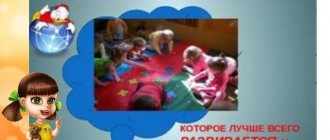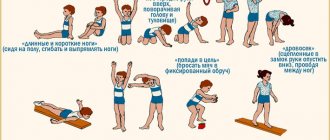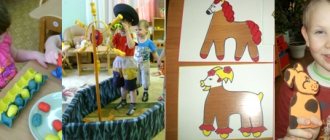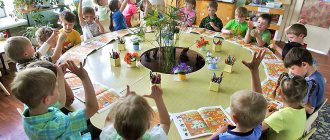MAGAZINE Preschooler.RF
Pedagogical project on “Introducing children to the origins of Russian folk culture through round dances and round dance games”OGKUSO "Center for Assistance to Children Without Parental Care, Cheremkhovo"
Round dance games have always been loved by both children and adults in Rus'. Not a single holiday would be complete without them.
Prepared by: Kashirina Evgeniya Sergeevna Teacher of group No. 1
Relevance:
At the turn of the twenty-first century, Russia is experiencing a crisis in educating the younger generation. Traditions were broken, the threads that connected the younger and older generations were broken. Ruthless cutting off of one's roots and rejection of nationality in the educational process leads to lack of spirituality and discourages children from expressing themselves creatively. Turning to musical folklore in the education of preschool children opens up wide opportunities for pedagogical creativity and a bold search for innovative methods of teaching and education.
Round dance games are almost forgotten. Many educators are faced with how difficult it is to organize kids. Especially to switch their attention from one type of activity to another. But round dance games are a faithful assistant in organizing children. As soon as you organize such a game, all the children immediately come running, grievances and quarrels are forgotten. The round dance game unites and brings children together. There is peace and tranquility in the group. Round dance games have long served as a means of self-knowledge. In these games, children showed their best qualities - kindness, nobility, mutual assistance, self-sacrifice for the sake of others.
The goal of the project: to introduce children to the origins of Russian folk culture through round dances and round dance games
Tasks:
- To analyze the level of knowledge of round dance games among children in the group.
- Prepare conditions for the implementation of the project.
- Use round dance games every day when working with children, using a variety of pedagogical forms, methods and techniques of work.
- To interest children in round dance games, to attract children to Russian folk culture.
- Develop children's musical, rhythmic, dance and speech abilities through round dance games.
- Systematize practical materials created during the project.
The project implementation period is 7 months.
Project participants:
- musical director
- physical education instructor
- educators
— children of group No. 1
Research methods:
- pedagogical observation
- children interview
— designing corners in the group for the cognitive development of children.
Expected Results
Results Products:
- calendar - long-term planning, card index of round dance games for middle-aged children, audio library for conducting musical round dance games, video library of round dance games
- notes, event scenarios
- photographs, videos of events
— attributes, elements of costumes for round dance games.
Results effects:
— Children have developed a strong interest in the origins of Russian folk culture through round dance and round dance games
-Children have a developed sense of rhythm and ear for music.
- Children know the poems that accompany round dance games.
- Improved motor skills (from slow walking to running).
- Children have developed a friendly attitude towards each other, the ability and desire to play round dance games together.
- Children have developed the ability to act together and cooperate.
- The children got acquainted with some ancient traditions and customs associated with round dance games.
Tasks and techniques for mastering round dance games
Age group
| Problems of round dance games | Organization of games | Mastering techniques | |
| First youngest (1.5–3 years) |
| Kids learn to stand in a circle and dance in a circle. At the beginning of learning round dance games, it is recommended to place a toy in the center of the circle; it will serve as a guide for the children. At first, it is difficult for children of the second year of life to move clearly in a circle. To help them, you can mark a circle on the floor with electrical tape or stickers. The song is performed by adults: teacher, music director, physical education instructor, parents. They learn the round dance game several times a week. | Demonstration of the game by adults (demonstrated by the teacher and nanny, music director and teacher, etc.). |
| Second youngest (3–4 years) |
| Movements in a circle become more difficult:
The songs are performed by adults, encouraging children to sing along. The round dance game is learned daily: at leisure, during a music lesson, while walking. |
|
| Medium (4–5 years) |
| Children perform round dance songs on their own. In the first half of the day, the teacher learns the text with the children, in the second half - the movements. | |
| Senior (5–6 years old) |
| Older preschoolers quickly learn the words of songs. And the movements of round dance games become more complex: formation according to the rules and formation of figures appear. It is recommended to learn round dance movements in the first half of the day, and the lyrics of the song in the second. The new game should be repeated with the children 2-3 times during the day, for reinforcement - 1-2 times. |
|
| Preparatory (6–7 years) |
|
Stages of mastering the round dance game
| Stage of mastering the round dance game | The content of the work |
| Preliminary work of the teacher | Before introducing the children to a new game, it is strongly recommended that the teacher analyze its components for himself:
|
| Preparatory stage for students |
|
| Unlearning |
As mentioned earlier, with younger and middle preschoolers they first learn a song, with older ones - the sequence and nature of movements. |
| Carrying out the game | Often in kindergarten a new round dance game is learned for some event at which the following will be held:
|
Card file of round dance games in kindergarten
| Group | Round dance games | What are the benefits for this age group? |
| Nursery (first junior) | "Inflate, bubble." Children walk in a circle holding hands. First, the teacher speaks the poetic text, then the children learn and pronounce the words in chorus. When the word “burst” sounds, the children break the chain, squat down and exhale: “Sh-sh-sh-sh...” A more complicated version: children walk in a circle, then it swells and bursts. "Legs." The children walk in a circle slowly, loudly stamping their feet: “Big feet walked along the road.” Then quickly and in small steps: “Little feet walked along the path.” "Carousel". Song accompaniment: “Barely, barely, barely the carousel turned.” In the center of the round dance there is a column with ribbons or a teacher with long ribbons attached to his belt. The song plays, the children hold on to the ends of the ribbons and spin the carousel at an ever-accelerating pace (according to the words of the song), then spin the ribbons in the opposite direction. | The games have simple song content, children are not distracted by the words. The round dance game develops children's coordination of movements and the ability to repeat. |
| Junior (second) | “The cat went to the stove.” Song accompaniment: “The cat went to the stove, found a pot of porridge.” Children lead a round dance, in the center of which the teacher, in the role of a cat, performs a song and acts out a role. This game is played in middle and senior groups with one of the children playing the role of a cat. "Matryoshka" Song: “And how clean our palms are.” Children walk in a circle and, together with the teacher, pronounce the words of the song and perform the movements described in the text. “We are walking through the forest.” To the words of the song of the same name. Children walk in a circle, saying which wild animal they call. "Circle". Children lead a round dance, saying: “Circle, circle, small step. One, two, three, turn around too!” The leader calls the name of the child, he turns, the round dance movement resumes, the name of the next child is called, etc. | In the song accompaniment of the games, words and lines are repeated, the children try to sing along with the teacher. Memory develops: children learn a song and sing in chorus. The game develops auditory attention: children respond to their name and complete tasks based on the lyrics of the song. |
| Average | "Zucchini" / "Cap". Song accompaniment: “Zucchini, zucchini - thin legs.” Children dance around the zucchini. After the song is performed by the round dance participants, the “zucchini” performs an impromptu dance and changes roles with another child. "Mice and Babies" / "Cat and Mouse". Song: “Oh, how tired the mice are!” Children are divided into two teams (mice and children/cats). Children form a circle, holding hands, raising them up. Mice run through the resulting gates while the song plays. When the song is over, the gate hands are lowered; whoever remains inside the circle is caught from the mice. "Bear". Song: “Like snow, snow under a hill.” Children dance in a round dance, now approaching and then moving away from the “bear” - a child who sits on a chair in the center of the round dance with his eyes closed. The last words of the song are spoken only by one of the participants, whose voice the “bear” must guess. "The mice dance in circles." To the words of the song of the same name. The presenter is selected, he sits on a chair in. At the last words of the song, the round dance falls apart, the leader tries to catch one of the guys. This game is often played in younger groups, the role of the leader and the song is performed by the teacher. "Teremok". Song: “There is a teremok in the field, a teremok.” Among the participants, those playing the roles of animals from the tower are selected. The children lead a round dance and sing a song, the “little animal” that is sung about in the verse runs along the circle. | Movement in a round dance becomes more difficult. The circular formation often breaks down in games with middle preschoolers. Games rapidly develop motor abilities: reaction speed, dexterity. |
| Senior and preparatory | “Thread” / “Thread with a needle.” Children stand in a chain. The first and second participants raise their hands, creating a hoop or eye of a needle into which the “needle” (the opposite end of the chain) should fall. "Dudar." Song: "Dudar, dudar, dudarishche." The presenter is in the center of the circle and answers the song question about what hurts him. After this, the round dance participants start the song again, holding on to the place that the dudar named. "Cabbage" Song: “Oh, cabbage, my seedlings!” The children practice twisting and unwinding the spiral in a round dance movement. "Wattle" Song: “We walk around the birch tree.” Children line up in a chain, facing in one direction, holding a long rope. When the song ends, the leader leads a round dance with a snake at a fast pace. Whoever fails to stay on his feet is eliminated. “Burners” / “Burn, burn clearly.” To the words of the song of the same name. A round dance chain is formed by pairs of participants lined up in a row. In front of the column is the leader - the burner. At the end of the song, the last pair of participants runs to the beginning of the chain, and the burner tries to hit one of the runners. "Candy wrappers." In the center of the round dance there is a leader, the guys agree with their eyes who will be the guesser. The presenter says: “Santa wrappers, limpopo!” The participants in the round dance repeat the movements after the wisher; he changes them quite often. The presenter tries to guess who the guys chose. "Handkerchief." A leader is chosen for the game - a peddler. Children dance in a circle, squat and close their eyes. The peddler covers one of the guys with a handkerchief. When the children open their eyes, the peddler asks who will come to the handkerchief and name the person hidden under it. | For older preschoolers, round dance games have complicated rules. The participants in the games act in collusion. The presenter shows ingenuity and dexterity. Children practice performing round dance patterns (snail, snake), thus expanding their spatial abilities. |
| < Previous | Next > |







